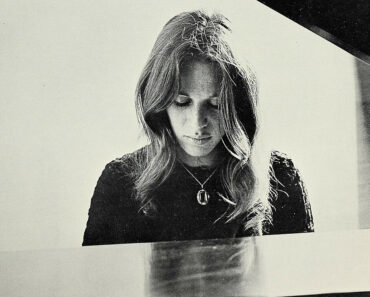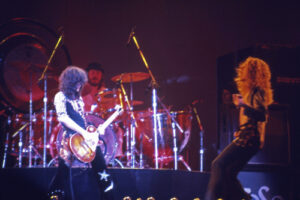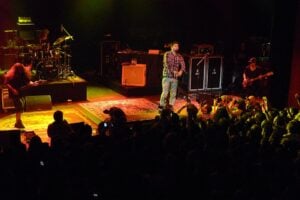
Feature Photo: slgckgc, CC BY 2.0 <https://creativecommons.org/licenses/by/2.0>, via Wikimedia Commons
Certain songs in classic rock history go beyond the norms of a simple pop or rock song and present an enthralling cinematic experience through music, lyrics, story, and production. Like reading a book, one’s imagination can play a key factor in experiencing the composer’s intent. Yet, of course, beyond the limitations of just the written word, a great cinematic song celebrates the advantage of music that can help guide the listener’s emotions while stopping short of presenting the images meant to be imagined.
# 10 – Paradise By The Dashboard Light – Meat Loaf
“Paradise by the Dashboard Light” by Meat Loaf is not just a rock song; it’s a full-blown cinematic experience encapsulated in eight minutes of musical storytelling. From its dramatic opening chords to its unexpected twists and turns, this track embodies the very essence of what makes a rock song cinematic. Taken from Meat Loaf’s 1977 album Bat Out of Hell, this multi-part epic is a perfect example of how rock music can use vivid imagery, narrative structure, and dynamic musical shifts to create a piece that feels as much like a movie as it does a song.
Read More: Top 10 Meat Loaf Songs
# 9 – Hurricane – Bob Dylan
Bob Dylan’s “Hurricane,” from his 1976 album Desire, stands as one of rock music’s most gripping and cinematic songs. The nearly nine-minute epic unravels the story of Rubin “Hurricane” Carter, a middleweight boxer wrongly convicted of murder in 1966. Dylan, a master storyteller, uses his songwriting to build a narrative rich with vivid imagery, real-life characters, and a powerful emotional arc that rivals any cinematic thriller. Recorded in July 1975 at Columbia Recording Studios in New York, “Hurricane” features Dylan’s characteristic nasal delivery over a driving violin and harmonica-laden folk-rock arrangement that heightens the song’s sense of urgency and drama.
Read More: Best Bob Dylan Songs Of The 1970s
# 8 – Indian Sunset – Elton John
Elton John’s “Indian Sunset,” a deep cut from his 1971 album Madman Across the Water, is an evocative narrative that plunges listeners into the tragic tale of a young Native American warrior grappling with the inexorable loss of his culture and homeland. Written by John’s longtime lyricist Bernie Taupin, the song stands out for its vivid storytelling and sweeping orchestration, creating an emotional and cinematic experience that captures the raw emotions of a man facing the annihilation of his world. Recorded at Trident Studios in London in 1971 and produced by Gus Dudgeon, “Indian Sunset” is a testament to John and Taupin’s ability to merge rock with theatrical elements, echoing the narrative ambition of rock operas and concept albums of the time.
Read More: Complete List Of Elton John Articles
# 7 – Mr. Tanner – Harry Chapin
“Mr. Tanner,” from Harry Chapin’s 1973 album Short Stories, is a quintessential example of how a song can feel like a short film, complete with a protagonist, a plot, and a poignant resolution. With a narrative that paints the rise and fall of a humble man’s dream, the song is an evocative entry in our list of the most cinematic rock songs. In it, Chapin weaves a tale of Martin Tanner, a dry cleaner from Dayton, Ohio, whose baritone voice is praised by his community. Despite his reservations, he is persuaded to pursue a career in music, only to face crushing rejection from the critics. It’s a story that unfolds like a slow burn, using Chapin’s folk-rock style to explore the emotional terrain of ambition and defeat.
# 6 – The Devil Went Down To Georgia – Charlie Daniels Band
Released in 1979 on their Million Mile Reflections album, this Southern rock classic narrates a riveting showdown between good and evil, set against the backdrop of a fiery fiddle duel. The song was recorded at Woodland Sound Studios in Nashville, Tennessee, with production helmed by John Boylan. The band, comprising Charlie Daniels on fiddle and vocals, Taz DiGregorio on keyboards, Fred Edwards and James W. Marshall on drums, Charlie Hayward on bass, and Tom Crain on guitar, creates a rich, layered sound that sets the stage for the tale’s intense drama. Daniels, with his commanding voice and virtuosic fiddle skills, brings the narrative to life, embodying both the fiery devil and the young protagonist, Johnny, who dares to take on the Prince of Darkness himself.
# 5 – Scenes From An Italian Restaraunt – Billy Joel
“Scenes from an Italian Restaurant,” released on Billy Joel’s 1977 landmark album The Stranger, is a masterful example of rock storytelling that unfolds like a short film. Spanning over seven minutes, this track takes the listener on a journey through time, weaving together multiple narratives and musical styles to create a vivid, cinematic tapestry. With its shifting tempos and melodies, Joel captures the essence of a New York City evening, bringing to life the stories of love, loss, and nostalgia with a skill rarely matched in rock music. Recorded at A&R Recording, Inc. in New York City, with production by Phil Ramone, “Scenes from an Italian Restaurant” features Billy Joel on piano and vocals, Liberty DeVitto on drums, Doug Stegmeyer on bass, and Richie Cannata on saxophone and clarinet.
# 4 – Big Joe and Phantom 309 – Tom Waits
Tom Waits’ rendition of “Big Joe and Phantom 309” from his 1975 album Nighthawks at the Diner taps into the evocative storytelling tradition that sits at the heart of American rock and country music. Originally written and performed by country artist Red Sovine in 1967, the song is a haunting ballad that spins a ghostly tale along the lonesome highways of America. Waits, known for his gravelly voice and penchant for dark, cinematic narratives, breathes new life into this classic trucker song, adding layers of mystery and melancholy that only he could deliver.
Read More: Complete List Of Tom Waits Albums And Songs
# 3 – Living In The City – Stevie Wonder
Stevie Wonder’s “Living for the City,” from his seminal 1973 album Innervisions, is a masterclass in storytelling through music, capturing the trials and tribulations of Black Americans navigating systemic racism, poverty, and the harsh realities of urban life. The song stands out not just for its powerful message but also for its cinematic structure, blending vivid narrative and raw emotion into an unforgettable musical experience.
Recorded in 1973 at Media Sound Studios in New York City and Crystal Sound Studios in Los Angeles, “Living for the City” features Wonder himself playing most of the instruments. “Living for the City” was a critical and commercial success, reaching number eight on the Billboard Hot 100 and topping the R&B singles chart. It earned Wonder a Grammy Award for Best Rhythm & Blues Song.
Read More: Top 25 Stevie Wonder Songs
# 2 – Jungleland – Bruce Springsteen
Bruce Springsteen’s “Jungleland,” the epic closing track from his 1975 album Born to Run, is perhaps one of the most cinematic songs in rock history. Spanning nearly ten minutes, the song is a sweeping narrative that captures the grit, romance, and desperation of life in the city. The first time I ever heard this song was in 1975 when I brought the Born to Run album, and after being blown away by everything I had heard already, this one just completely floored me.
Read More: Top 10 Bruce Springsteen Albums


![Desire [Explicit]](http://m.media-amazon.com/images/I/510annmbu6L._SL500_.jpg)
![Madman Across The Water [LP]](http://m.media-amazon.com/images/I/61W1eKi4ubL._SL500_.jpg)


![The Stranger [Vinyl]](http://m.media-amazon.com/images/I/51P63qHAxrL._SL500_.jpg)






































